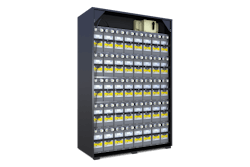How Edge Computing is Reshaping Backup Power Strategies
Mobile network infrastructure has been transformed to support faster speeds, higher bandwidth and ultra-low latency of 5G. One major evolution is edge computing. By moving data processing and storage closer to the network edge, quality improves, and key performance indicators (KPIs) can be met. Such a shift does more than revolutionize data handling and service delivery; it places new—and higher—demands on uninterruptible power supply (UPS) backup systems.
Backup power cannot be an afterthought for multiple reasons. While 5G enhances energy efficiency per transmitted bit, overall energy consumption increases due to the denser infrastructure and rising data demands. Plus, the growing mission-critical nature of emerging use cases means innovative power solutions are needed to enhance the reliability and efficiency of 5G networks. Outages can be life-threatening and cost over $100,000 per hour.
Edge computing: Decentralized demands, centralized challenges
The need for ultra-low latency and real-time data processing has led mobile operators to shift from centralized architectures to the distributed nature of edge computing. Integration of edge computing contributes to higher energy demands, as processing data closer to the user requires significant computational resources. Energy consumption also rises on the radio side, so energy resources must be carefully managed.
Edge computing brings unique backup power challenges compared to centralized networks:
- Design differences: Edge sites often have space and budget constraints, requiring compact, reliable and easy-to-maintain battery systems. Unlike centralized architectures, redundancy and scalability must be implemented more creatively and efficiently.
- Downtime is not an option: As networks become more reliant on edge nodes for services such as video streaming and IoT, even brief outages can cause widespread disruption. Ensuring maximum uptime with intelligent backup power design is mission-critical.
- Sustainability goals: Operators face increasing pressure to meet environmental targets. Edge facilities must deploy backup power solutions with the environment in mind. For example, advanced lead-acid batteries support energy efficiency without sacrificing performance.
- Cost efficiency: With a greater number of sites, managing total cost of ownership (TCO) is vital. That means selecting battery systems (figure 1) that minimize maintenance, offer longer life cycles, and lower capex and opex.
Designing UPS based on application
Operators must design a backup power system that addresses the specific requirements of edge computing. The three main considerations are:
Power quality and availability
Power availability is a main consideration for a simple reason—without power, there is no data. Will the power source, be it the grid, wind, solar or something else, support the demand? If not, the backup system will be used regularly. Understanding these factors will help select the best battery for the application.
For example, float batteries are very power efficient but must always be charged so they can be used on call. If a float battery is used regularly, it will have a shorter life and lower return on investment (ROI) because more frequent battery changeouts are needed.
Cycling batteries are the choice for on-off applications because they can better handle regular use. The trade-off is they are not as power-dense as float batteries, which often leads to an oversized system.
Capacity on day one of the data center is also a consideration. If capacity is 100% when the doors open, there must be enough power to support it. Future power needs—and the source—must also be part of the system design.
Sustainability
True sustainability must account for the full-life battery cycle with all three factors: sourcing, operating and disposing. Selecting a battery from a manufacturer who acts responsibly, ethically and with integrity throughout the design and manufacturing processes will ensure a battery is responsibly sourced.
Every battery chemistry has a different recycling program. Long-standing technologies, such as lead acid, with well-established ecosystems, pay you to recycle batteries. Newer technologies, such as lithium-ion, are still building those ecosystems, so there may be a cost to recycle batteries.
Every customer must have a very clear understanding of what it means to be sustainable. It will ensure that all its products and suppliers are aligned with that vision.
TCO
Getting the greatest ROI means looking past the initial battery price and seeing lifetime costs. To accurately determine TCO, a holistic approach that considers four factors must be taken:
Installation (capex): Installation includes day one costs, such as the batteries, cabinets or racks, and any labor to connect the system.
Maintenance (opex): The frequency of maintenance needed is the biggest factor. There is the potential for higher-skilled labor, depending on the technology chosen, as well.
Replacement (opex): Every asset, regardless of technology, is finite, and all batteries will need to be replaced eventually. For replacements, cost will, of course, be an important factor, but it will also be heavily influenced by frequency, supply chain resiliency, and lead times.
When comparing different technologies, it can be very hard to determine battery replacement costs. While there isn’t one approach, it is highly recommended to start a TCO calculation using the standard warranty provided for each technology. A warranty is a clear sign of how much a company is willing to stand behind its products, making it the only fair way to compare alternatives. However, you must be careful with special one-off warranties, as well, and use the standard warranty as the true measure.
Disposal: Battery manufacturers must be committed to a cradle-to-grave approach to disposing of their lead-acid battery products. A viable lead-acid battery collection and recycling program provides an eco-friendly, safe, convenient, low-cost recycling option.
Future-proofing telecom networks with smarter backup power
Edge computing is forcing operators to rethink backup power systems. The shift towards smart, sustainable, and scalable power solutions is not just a trend—it’s a necessity. The best solutions will help operators reduce TCO, improve system reliability, and advance sustainability initiatives while supporting emerging services.
For related articles, visit the 4G & 5G Topic Center.
For more information on solutions and suppliers across broadband, network reliability, FTTX and more, explore the ISE Buyer's Guide.
To stay up-to-date on ICT trends, subscribe to our ISE Newsletters.
About the Author

Erick Soares
Director of Product Managment, Stationary, C&D Technologies
Erick Soares is Director of Product Management, Stationary at C&D Technologies, has a master’s degree in marketing, and has been a part of the battery industry since 2019.

